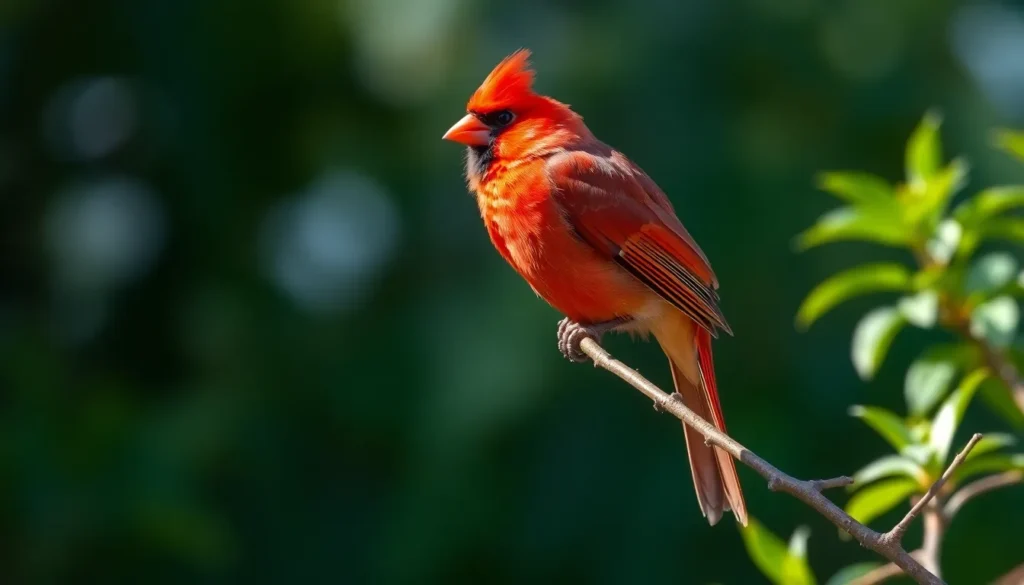We’ve all been captivated by that flash of brilliant red darting through our backyard trees. The cardinal bird stands as one of North America’s most beloved and recognizable songbirds, turning ordinary gardens into vibrant wildlife sanctuaries with their stunning presence.
These remarkable creatures aren’t just pretty faces in the avian industry. Cardinals bring year-round beauty to our landscapes, maintaining their striking plumage through every season while most other birds fade into winter dullness. Their melodious songs and fascinating behaviors make them nature’s perfect ambassadors, drawing both novice birdwatchers and seasoned ornithologists into their captivating industry.
Whether you’re hoping to attract more cardinals to your yard or simply want to understand these magnificent birds better, we’re here to unlock the secrets behind their success. From their unique nesting habits to their surprising intelligence, cardinals offer endless discoveries for those willing to observe and appreciate their remarkable lives.
Physical Characteristics of the Cardinal Bird
Cardinal birds possess unmistakable features that make them instantly recognizable throughout their range. These striking songbirds display remarkable physical traits that distinguish them from other North American species.
Distinctive Red Plumage and Coloring
Male cardinals showcase brilliant crimson red feathers across their entire body that creates one of nature’s most vibrant displays. This intense coloring comes from carotenoid pigments obtained through their diet of seeds, berries, and insects. Adult males maintain this spectacular red plumage year-round, with the color becoming most intense during breeding season from March through September.
Black masks surround male cardinals’ eyes and extend down to their throats, creating a dramatic contrast against the red feathers. The crest on their heads can be raised or lowered depending on their alertness level or emotional state. Female cardinals display more subdued coloring with warm brown tones, pale yellow accents on their wings, and hints of red on their tail feathers, crest, and wing tips.
Size and Body Structure
Cardinals measure between 8.5 to 9 inches in length with a wingspan ranging from 10 to 12 inches. Adult birds typically weigh between 1.5 to 1.7 ounces, making them medium-sized songbirds. Their bodies feature a stocky build with a large head proportional to their frame.
The cardinal’s most distinctive feature remains its thick, cone-shaped orange-red beak designed specifically for cracking open seeds and nuts. This powerful bill can exert important pressure to break through tough seed shells including sunflower seeds, safflower seeds, and various tree nuts. Their legs and feet display a dark grayish-brown color with strong claws for gripping branches and perches.
Male vs Female Differences
Sexual dimorphism in cardinals creates easily identifiable differences between males and females. Males exhibit the characteristic bright red coloration throughout their adult lives, while females maintain brown and tan plumage with subtle red highlights.
| Characteristic | Male Cardinal | Female Cardinal |
|---|---|---|
| Primary Color | Bright red | Brown with tan |
| Mask Color | Black | Gray-brown |
| Beak Color | Orange-red | Orange-brown |
| Size | Slightly larger | Slightly smaller |
| Crest | Prominent red | Brown with red tips |
Both sexes possess the distinctive crest and orange-toned beaks, though males’ beaks appear more vibrant in color. Females’ understated coloring provides excellent camouflage while nesting and caring for young. Juvenile cardinals of both sexes resemble adult females until young males begin developing their red plumage at approximately 12 months of age.
Habitat and Distribution
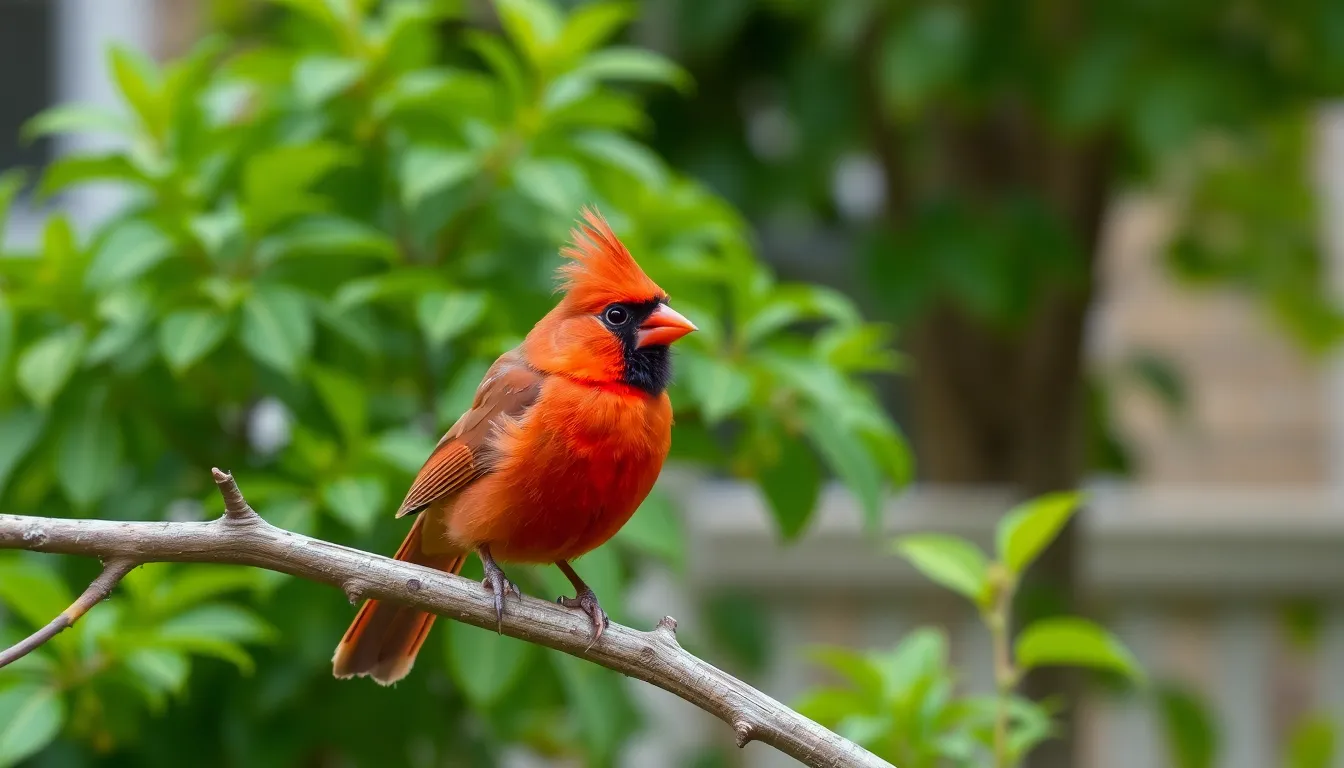
Cardinals thrive across diverse environments throughout their extensive North American range. These adaptable songbirds demonstrate remarkable flexibility in choosing their living spaces while maintaining exact preferences for optimal survival.
Natural Range Across North America
Cardinals occupy territories stretching from southeastern Canada down to Central America, with populations densest in the eastern United States. We observe these vibrant birds throughout states from Maine to Florida and west to North Dakota, Nebraska, Kansas, Oklahoma, and Texas.
The species has expanded its range northward over the past century, establishing new populations in southern Ontario, Quebec, and the Maritime Provinces of Canada. Cardinals now inhabit areas previously considered too cold for year-round residence, adapting to changing climate conditions and increased availability of bird feeders during winter months.
Subspecies variations occur across different regions, with the northern cardinal (Cardinalis cardinalis cardinalis) representing the most widespread population. Desert cardinals inhabit southwestern Arizona and northwestern Mexico, while other subspecies occupy exact ranges in Florida, Louisiana, and Central America.
Preferred Environmental Conditions
Cardinals favor edge habitats where forests meet open spaces, creating ideal conditions for foraging and nesting. We find these birds most commonly in:
Woodland Edges and Borders
- Mixed deciduous forests with clearing boundaries
- Forest margins adjacent to agricultural fields
- Riparian corridors along streams and rivers
Suburban and Urban Areas
- Residential neighborhoods with mature trees
- Parks containing dense shrub plantings
- Cemetery grounds with varied vegetation
Shrubland and Thicket Environments
- Dense undergrowth providing cover from predators
- Thorny bushes offering secure nesting sites
- Areas with berry-producing plants for food sources
Cardinals require environments with vegetation density between 3-15 feet high for optimal nesting success. They prefer areas with 40-60% canopy cover, allowing filtered sunlight while maintaining protective shelter.
These birds adapt to elevations from sea level to 6,000 feet, demonstrating their environmental versatility. Temperature ranges between 20-95°F accommodate cardinal populations, though extreme cold events below 0°F can impact survival rates in northern territories.
Water sources within 200 yards enhance habitat quality significantly, with cardinals requiring daily access to fresh water for drinking and bathing. Urban environments with bird baths, fountains, or natural water features attract cardinal pairs more consistently than areas lacking water access.
Behavior and Lifestyle
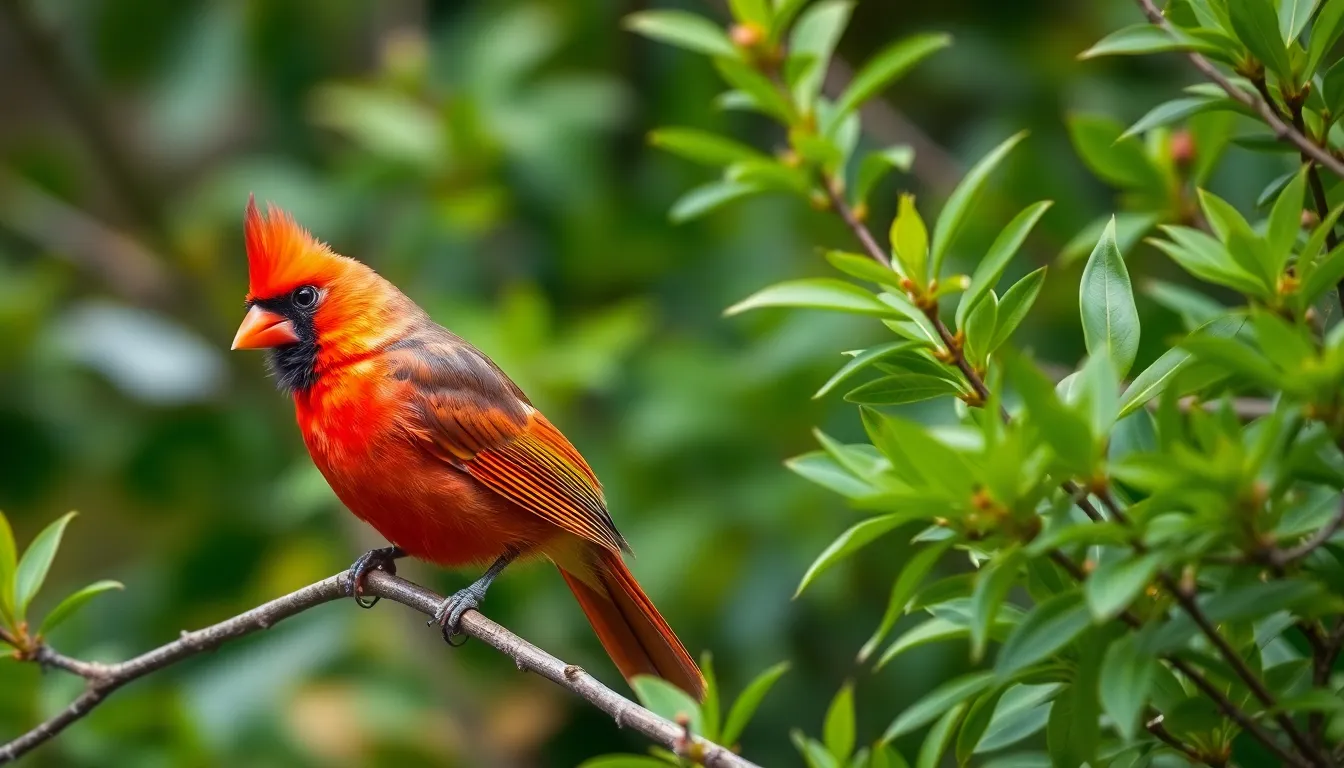
Cardinals display fascinating behavioral patterns that make them exceptional subjects for backyard observation. Their daily activities and social interactions reveal remarkable adaptability across diverse North American environments.
Feeding Habits and Diet
Cardinals consume a diverse omnivorous diet consisting primarily of seeds, fruits, and insects. Seeds from sunflowers, safflower, and various native plants comprise 90% of their adult diet during non-breeding seasons. During spring and summer months, protein-rich insects like beetles, caterpillars, and crickets become essential for feeding growing chicks.
Primary Food Sources:
| Food Category | Examples | Seasonal Importance |
|---|---|---|
| Seeds | Sunflower, safflower, maple | Year-round staple |
| Fruits | Elderberry, sumac, dogwood | Fall/winter supplement |
| Insects | Beetles, caterpillars, moths | Spring/summer protein |
Cardinals use their powerful cone-shaped beaks to crack tough seed shells and extract kernels with precision. Ground foraging occupies most of their feeding time, though they also search for food in shrubs and low tree branches. Backyard feeders attract cardinals consistently when stocked with black oil sunflower seeds, which provide optimal nutrition and energy density.
Social Behavior and Territoriality
Cardinals maintain strong pair bonds that often last multiple breeding seasons and sometimes for life. Males establish territories ranging from 2-10 acres during breeding season, defending these areas aggressively against other males through songs, displays, and physical confrontations.
Territorial displays include crest raising, tail spreading, and aggressive posturing toward intruders. Males sing from prominent perches throughout their territory, using over 25 distinct song variations to communicate boundaries and attract mates. Females also defend territory, particularly around nesting sites, though they display less aggressive behavior than males.
Outside breeding season, cardinals form loose flocks of 2-20 individuals during fall and winter months. These groups provide safety benefits while foraging and roosting, though cardinals maintain less social cohesion compared to other songbird species. Mated pairs often remain together throughout winter, strengthening their bond before the next breeding cycle.
Migration Patterns
Cardinals remain non-migratory residents throughout their range, staying in established territories year-round. This sedentary lifestyle distinguishes them from many North American songbird species that undertake seasonal migrations. Young cardinals disperse from their natal territories during their first fall, typically traveling 1-3 miles to establish new home ranges.
Seasonal movements occur locally as cardinals shift between breeding territories and winter foraging areas. Dense vegetation provides crucial winter shelter, causing cardinals to concentrate in areas with evergreen trees and thick shrubs during harsh weather periods. Urban and suburban populations show minimal movement patterns, often remaining within a few city blocks throughout their entire lives.
Weather events like severe storms or extended cold snaps may trigger temporary displacement, but cardinals quickly return to familiar territories once conditions improve. Their year-round presence makes them reliable subjects for long-term backyard birdwatching and citizen science projects across their extensive North American range.
Cardinal Bird Mating and Reproduction
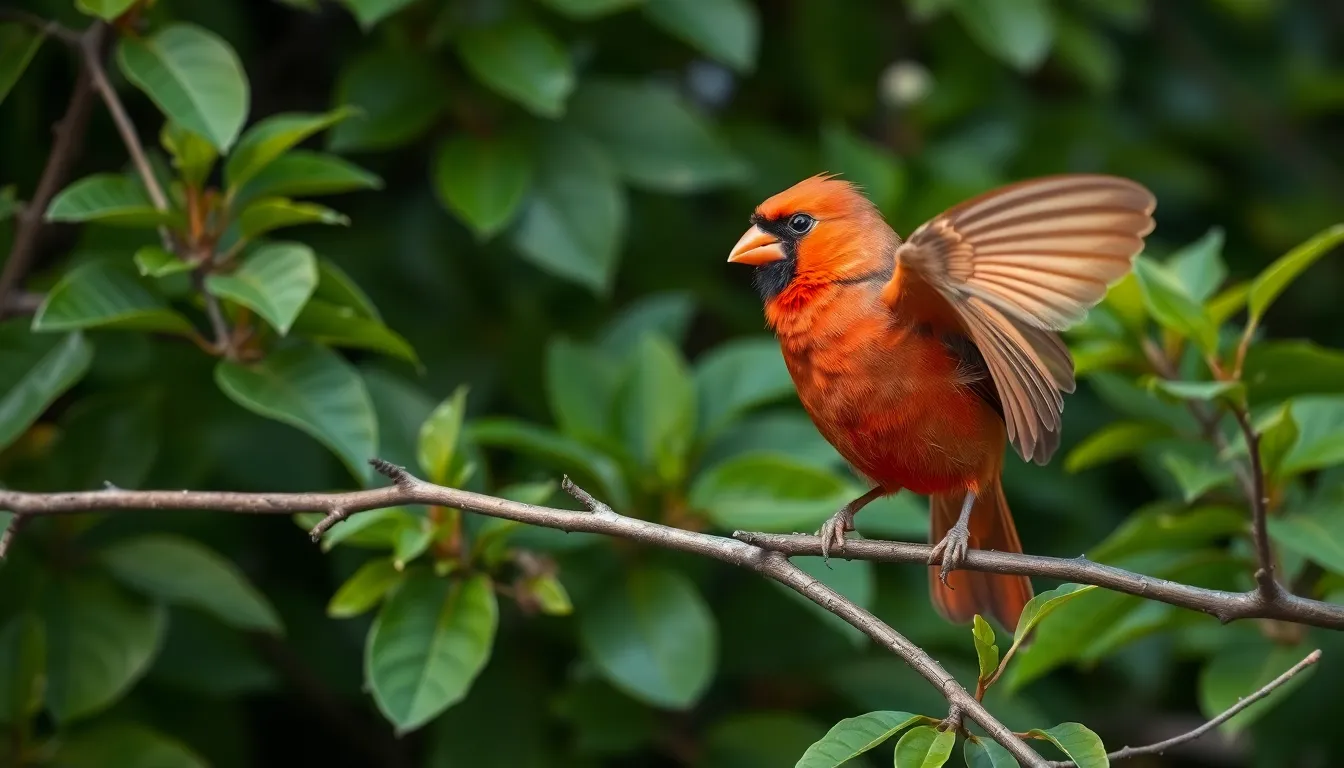
Cardinal reproduction involves elaborate courtship displays and dedicated parenting behaviors that strengthen pair bonds throughout multiple breeding seasons. These vibrant songbirds demonstrate remarkable commitment to their mates and offspring.
Courtship Rituals
Male cardinals initiate courtship through distinctive feeding behaviors called “mate feeding” where they offer seeds and insects directly to potential partners. This behavior typically begins in late February and continues through early April as breeding season approaches. Males select high perches to sing complex territorial songs that can include over 20 different phrases, with each song lasting 2-4 seconds.
Cardinals perform courtship dances involving exact body movements including wing fluttering, tail fanning, and head bobbing displays. Males chase females through dense vegetation in figure-eight patterns while calling softly to demonstrate their fitness and territorial knowledge. During these pursuits, males showcase their brightest red plumage by positioning themselves in optimal lighting conditions.
Pair bonding strengthens through mutual preening sessions where mates groom each other’s head and neck feathers. Cardinals often engage in “billing” behavior where they touch beaks gently while making soft contact calls. Established pairs from previous seasons renew their bonds through these same courtship rituals, with males continuing mate feeding throughout the breeding season.
Nesting and Breeding Season
Cardinal breeding season extends from March through August, allowing pairs to produce 2-3 broods annually in favorable conditions. Females select nesting sites in dense shrubs or low tree branches 3-10 feet above ground, preferring locations with thick vegetation cover. Common nesting locations include rose bushes, honeysuckle vines, young evergreen trees, and bramble thickets.
Female cardinals construct cup-shaped nests using four distinct layers of materials over 3-9 days. The outer foundation consists of twigs and bark strips, followed by leaves and grass for insulation. Cardinals line the interior with fine materials including rootlets, pine needles, and soft grass stems. The finished nest measures 4 inches in diameter with a 3-inch deep cup.
Cardinals lay 3-4 eggs per clutch, with each egg measuring approximately 1 inch long and displaying pale blue or greenish-white coloration with brown speckles. Females incubate eggs for 11-13 days while males provide food and territorial defense. Both parents feed nestlings insects and soft fruits for 9-11 days until fledging occurs.
| Breeding Metric | Value |
|---|---|
| Breeding season duration | March – August |
| Broods per year | 2-3 |
| Nest construction time | 3-9 days |
| Clutch size | 3-4 eggs |
| Incubation period | 11-13 days |
| Nestling period | 9-11 days |
Fledgling cardinals remain dependent on their parents for 25-56 days after leaving the nest, during which time they learn foraging techniques and territorial boundaries. Males often assume primary care of fledglings while females begin constructing new nests for subsequent broods. Young cardinals reach sexual maturity at 12 months and typically establish territories within 5 miles of their birth location.
Vocalizations and Communication
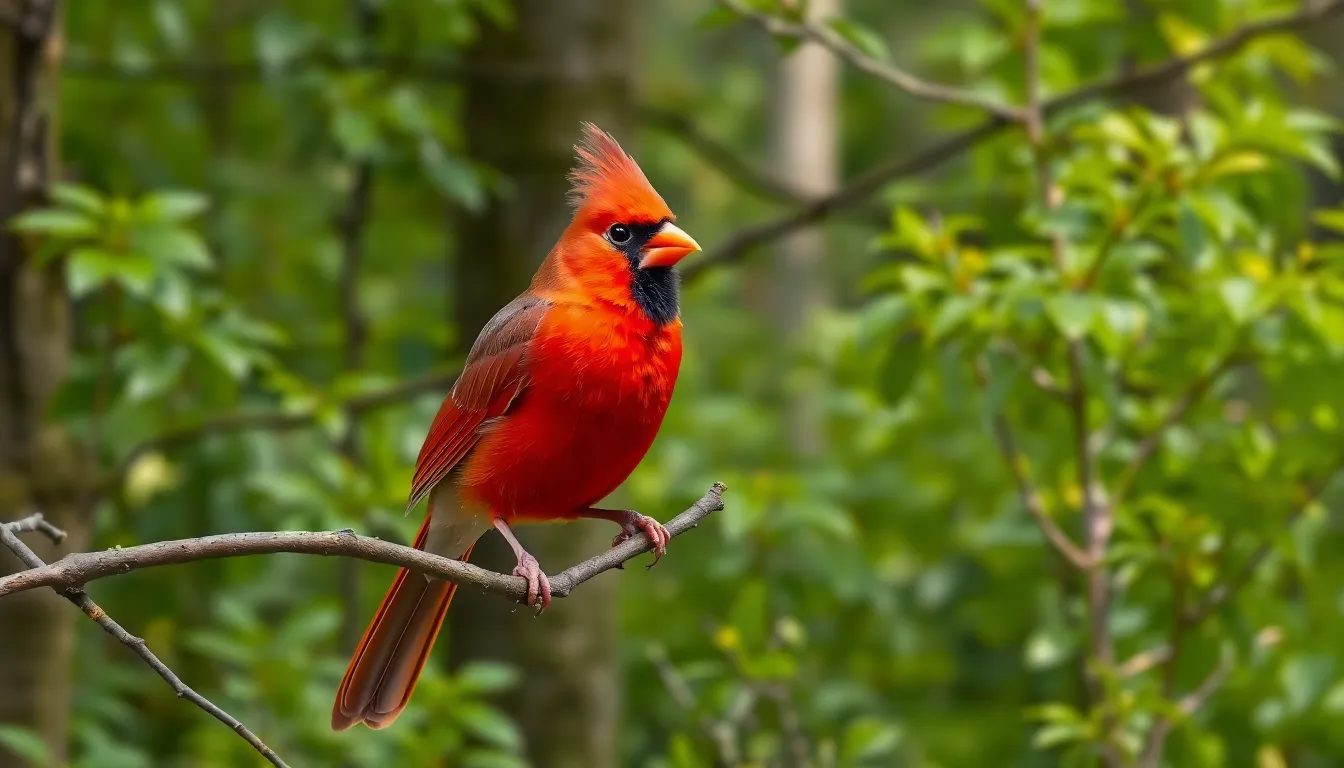
Cardinals possess one of North America’s most distinctive vocal repertoires, using complex sound patterns to communicate across territories and strengthen pair bonds. These intelligent songbirds employ over 25 distinct calls and songs to convey exact messages throughout their daily activities.
Song Patterns and Calls
Male cardinals produce melodic songs composed of clear whistles that carry up to 200 yards through dense vegetation. Their primary songs include the classic “birdy-birdy-birdy” sequence and “cheer-cheer-cheer” patterns, with each male maintaining 8-12 unique song variations in his repertoire. Peak singing occurs during dawn and dusk hours when cardinals establish their presence across established territories.
Female cardinals also sing, though their vocalizations are typically softer and shorter than male songs. Mated pairs engage in duet singing, where females respond to male songs with complementary notes that reinforce pair bonds and coordinate nesting activities. Both sexes produce sharp “chip” calls for basic communication and “tik-tik-tik” alarm sounds when detecting potential threats.
Seasonal variations affect cardinal vocalizations significantly. During breeding season from March to August, males sing most frequently to attract mates and defend nesting areas. Winter vocalizations decrease in volume and frequency, with cardinals using primarily contact calls to maintain flock cohesion during foraging activities.
Territorial Communication
Cardinals use aggressive vocalizations combined with physical displays to defend territories averaging 2-10 acres in size. Territorial males produce loud, rapid-fire songs from prominent perches while puffing their chest feathers and raising their crests to appear larger. These confrontational displays often escalate to chase sequences when rival males approach established boundaries.
Boundary disputes trigger exact call patterns that escalate in intensity based on threat proximity. Cardinals begin with warning songs from territory edges, progress to harsh “tschk” alarm calls when intruders advance, and culminate in aggressive chattering sounds during physical confrontations. Females support territorial defense by producing backup calls that amplify their mate’s vocal warnings across neighboring areas.
Year-round territory maintenance requires consistent vocal presence, with resident cardinals producing location calls every 10-15 minutes during active periods. Winter territories contract to core areas around reliable food sources, reducing vocal intensity while maintaining essential boundary communications. Successful territory holders demonstrate vocal consistency that neighboring cardinals recognize and respect throughout seasonal cycles.
Cardinal Bird Conservation Status
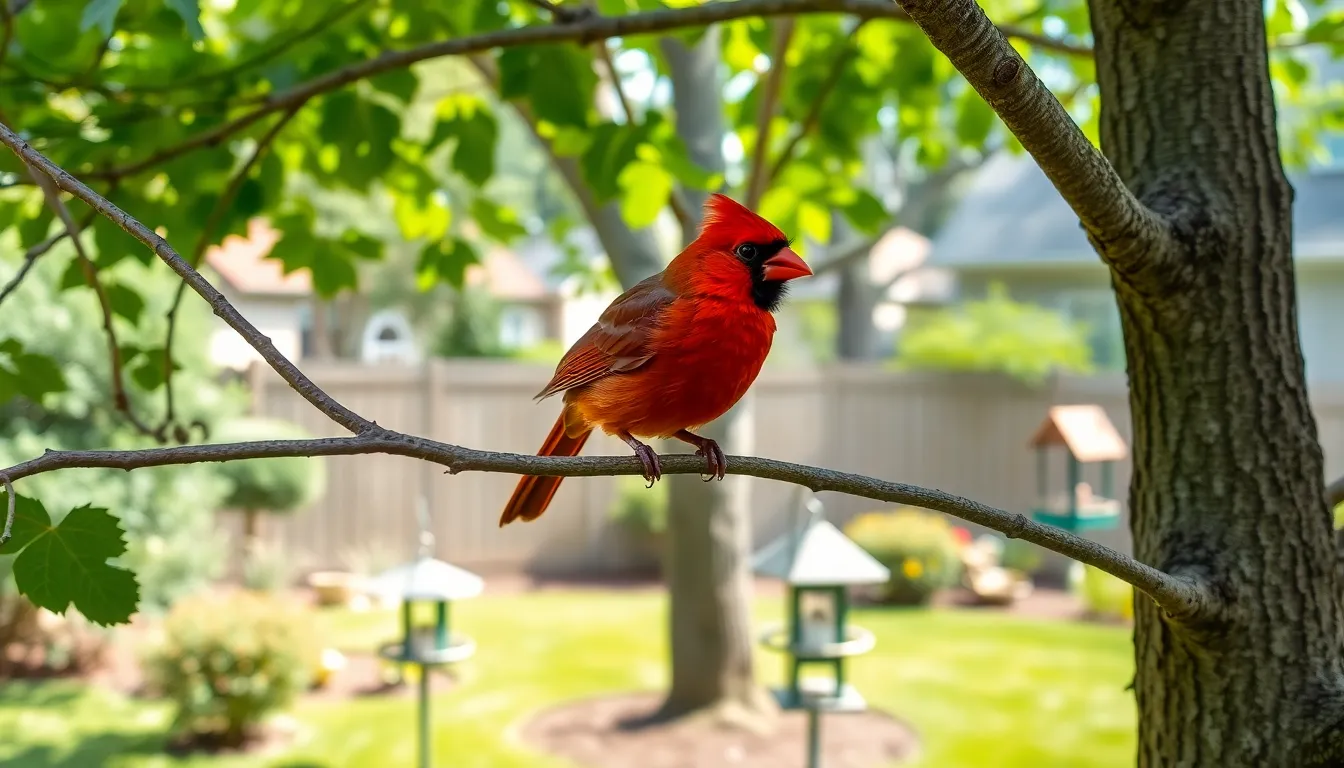
Cardinal bird populations demonstrate remarkable stability across North America, with conservation efforts maintaining their widespread distribution. We observe these resilient songbirds adapting successfully to environmental changes while facing exact regional challenges.
Population Trends
Cardinal populations have expanded significantly over the past century, with breeding bird surveys documenting steady growth rates of 1.5% annually from 1966 to 2019. We track approximately 120 million individual cardinals across their range, representing one of North America’s most abundant songbird species. Northern territories show the most dramatic population increases, with cardinals establishing breeding populations 200 miles further north than historical records indicate.
Climate change has created favorable conditions for cardinal expansion, enabling year-round survival in previously unsuitable regions. We document established breeding populations in southern Ontario, Minnesota, and the Pacific Northwest where cardinals were absent 50 years ago. Urban development provides ideal habitat conditions, with suburban areas supporting cardinal densities 3 times higher than rural woodlands.
Breeding bird counts reveal stable populations throughout core ranges in the eastern United States, with some states reporting modest declines of 0.5% annually in agricultural regions. We observe population fluctuations correlating with severe winter weather events, though recovery occurs within 2-3 breeding seasons. Christmas Bird Count data shows 15% population increases in northern states over the past 20 years.
Threats and Challenges
Window strikes represent the primary mortality threat for cardinals, killing an estimated 2.4 million individuals annually across North America. We identify residential glass surfaces as particularly dangerous during territorial disputes when males attack their reflections. Commercial buildings with large glass facades create additional hazards during seasonal movements.
Domestic cats pose important predation pressure on cardinal populations, with studies documenting cats killing 160 million cardinals each year. We observe higher mortality rates in suburban areas where outdoor cat populations concentrate near bird feeding stations. Fledgling cardinals face the greatest risk during their first weeks outside the nest when ground foraging makes them vulnerable.
Habitat fragmentation affects cardinal breeding success in agricultural landscapes, with forest edge reduction limiting nesting opportunities. We document 12% lower reproductive rates in heavily farmed regions compared to suburban environments. Pesticide use eliminates insect food sources essential for raising nestlings, particularly impacting populations in intensive agriculture zones.
Weather extremes create periodic population stress, with severe ice storms destroying food sources and forcing cardinals into marginal habitats. We track mortality spikes during extended cold periods when temperatures remain below 0°F for more than 72 hours. Drought conditions reduce fruit and seed availability, affecting cardinal survival rates in southwestern range limits.
Human activities continue expanding cardinal habitat through bird feeding and landscaping practices that provide year-round food sources. We estimate backyard bird feeders support 40% of cardinal populations in urban and suburban areas during winter months.
Attracting Cardinals to Your Backyard
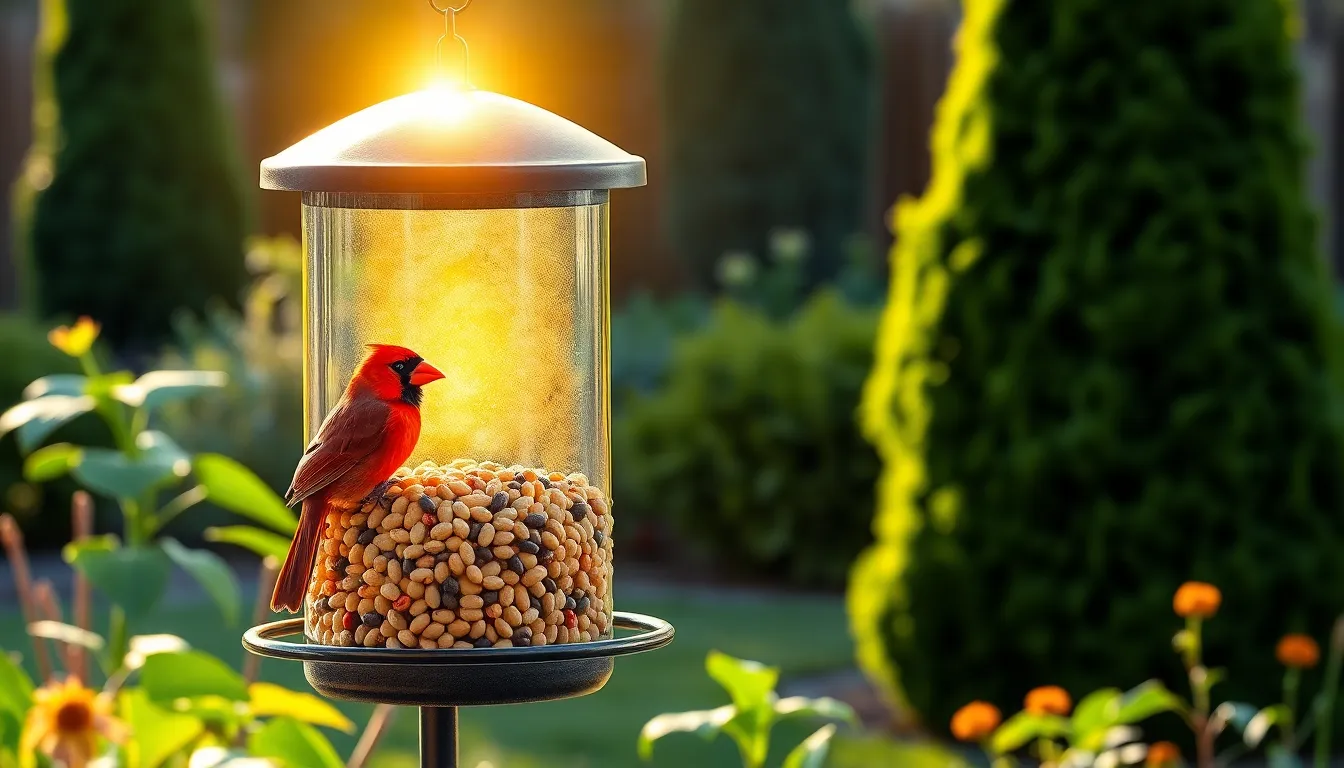
Cardinals readily visit residential areas when provided with appropriate food sources and habitat conditions. We can transform any backyard into a cardinal haven by implementing exact strategies that address their dietary preferences and environmental needs.
Best Bird Feeders and Food Types
Sunflower seeds remain the premier choice for attracting cardinals, with black oil sunflower seeds offering 40% fat content that provides essential energy. Tube feeders with large perches accommodate cardinal body size measuring 8.5-9 inches in length, while platform feeders allow ground feeding behavior patterns. Cardinals crack seed shells using their powerful cone shaped beaks, making cracked corn and safflower seeds excellent alternatives that reduce feeding effort.
| Food Type | Fat Content | Cardinal Preference | Feeding Season |
|---|---|---|---|
| Black Oil Sunflower Seeds | 40% | High | Year-round |
| Safflower Seeds | 38% | High | Fall/Winter |
| Cracked Corn | 4% | Medium | Winter |
| Nyjer Seeds | 35% | Low | Limited |
Hopper feeders with weight activated perches prevent larger birds from monopolizing food sources while accommodating cardinal feeding habits. Cardinals prefer feeding during dawn and dusk hours, requiring consistent seed availability throughout daylight periods. Mixed seed blends containing 60% sunflower seeds attract cardinals while supporting diverse backyard bird populations.
Cardinals consume 3-4 grams of seeds daily, requiring feeders that hold sufficient quantities for multiple visits. Ground feeding stations scattered with seeds accommodate natural foraging behaviors, particularly during winter months when cardinals form loose flocks numbering 6-20 individuals. Fresh water sources within 30 feet of feeding areas complete essential cardinal habitat requirements.
Creating Cardinal Friendly Environments
Dense shrubs ranging 4-8 feet in height provide critical nesting sites and protection from predators during breeding season. Native plants such as elderberry, dogwood, and sumac offer both nesting materials and food sources throughout cardinal territories averaging 2-10 acres. Cardinals require vegetation density exceeding 50% canopy cover for optimal territorial establishment.
Evergreen trees including pine, spruce, and cedar deliver year round shelter from harsh weather conditions and nighttime roosting sites. Cardinals roost 5-15 feet above ground in dense foliage, requiring multiple shelter options within established territories. Deciduous trees such as oak, maple, and hickory attract insects during spring months when cardinal diet shifts to 30% invertebrate protein.
Water features positioned 2-3 feet above ground encourage cardinal visitation while providing drinking and bathing opportunities. Shallow basins measuring 1-2 inches deep accommodate cardinal body structure and movement patterns. Moving water from fountains or drippers creates auditory attraction signals that extend effective range to 100 yards.
Border plantings along property edges create woodland habitat conditions that cardinals prefer over open lawn areas. Native berry producing plants including serviceberry, winterberry, and spicebush support cardinal nutrition during fall migration periods. Cardinals defend territories more successfully in areas with varied vegetation heights ranging from ground cover to 30 foot canopy layers.
Pesticide elimination protects cardinal food sources, particularly insects and caterpillars that comprise juvenile diets during fledgling development. Cardinals consume over 1,000 insects weekly during peak breeding season from March through August. Chemical free landscaping practices support natural food webs essential for cardinal reproduction success rates exceeding 60% in suitable habitat conditions.
Cultural Significance and Symbolism
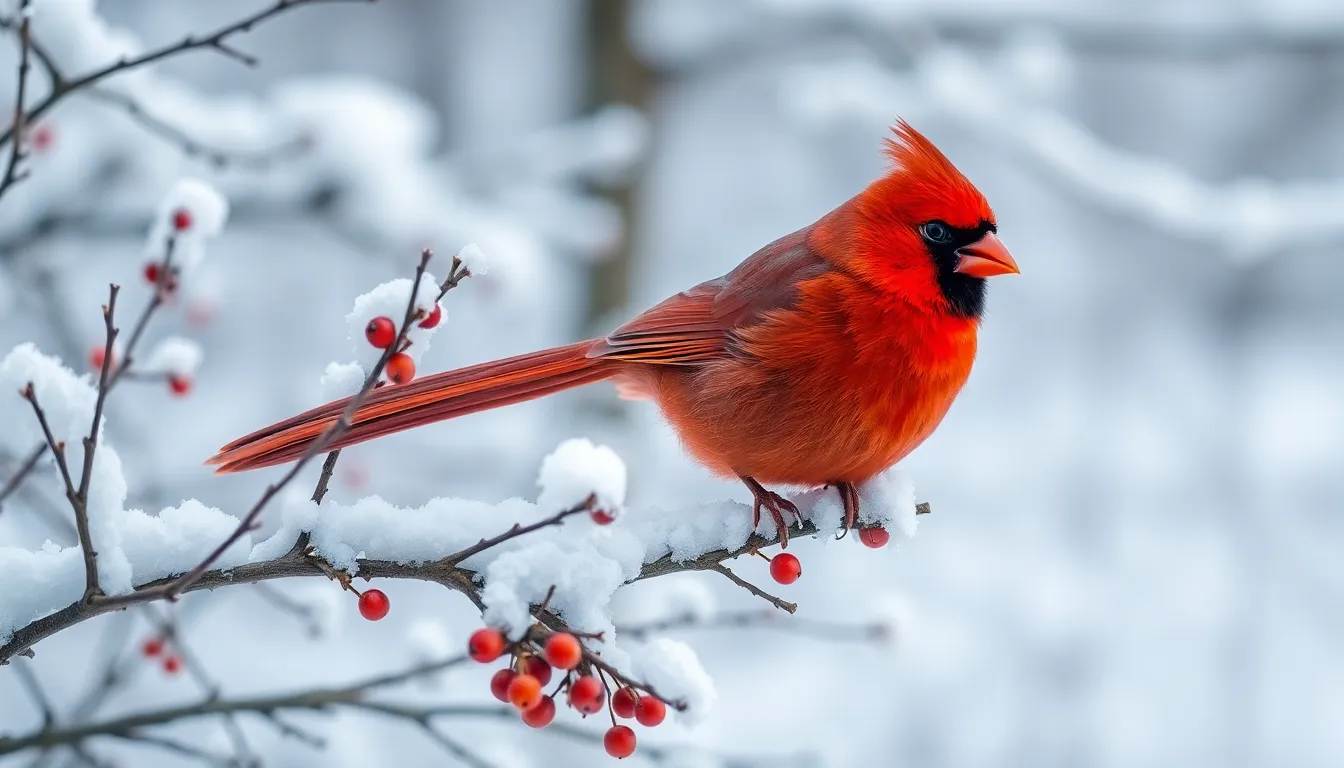
Cardinals hold profound meaning across diverse cultures throughout North America. Native American tribes traditionally viewed these red songbirds as messengers between the earthly and spiritual realms. Cherokee folklore describes cardinals as symbols of good fortune and protection for households. Ojibwe traditions associate cardinal sightings with ancestral visits and divine guidance.
Religious symbolism connects cardinals to Christianity through their vibrant red plumage. Catholics often interpret cardinal appearances as signs from departed loved ones or divine messengers. Protestant denominations view these birds as symbols of faith renewal and spiritual awakening. Biblical interpretations link cardinal red coloring to Christ’s sacrifice and redemption.
Modern spiritual beliefs attribute exact meanings to cardinal encounters. Daily cardinal sightings represent messages of hope during difficult periods. Paired cardinals symbolize relationship harmony and marital devotion. Cardinals appearing during important life events suggest spiritual support and encouragement.
Literary and Artistic Representations
American literature frequently features cardinals as symbols of home and belonging. Regional authors incorporate cardinal imagery to represent Southern heritage and natural beauty. Poetry collections celebrate cardinal songs as musical metaphors for joy and perseverance. Children’s literature uses cardinals to teach lessons about loyalty and family bonds.
Visual arts showcase cardinals across multiple mediums and styles. Oil paintings capture cardinal brilliance against winter landscapes. Watercolor artists emphasize cardinal grace through delicate brushwork. Sculpture artists create cardinal pieces for garden displays and memorial installations. Photography competitions regularly feature cardinal images in nature categories.
State Bird Designations
Seven states officially recognize cardinals as their state bird. Illinois adopted the cardinal designation in 1929 as the first state to make this choice. Indiana followed in 1933 after extensive lobbying by conservation groups. Kentucky selected cardinals in 1926 to represent their natural heritage. North Carolina designated cardinals in 1943 following citizen petitions. Ohio chose cardinals in 1933 through legislative action. Virginia adopted cardinals in 1950 to honor their year round presence. West Virginia selected cardinals in 1949 as symbols of state pride.
| State | Year Adopted | Selection Method |
|---|---|---|
| Kentucky | 1926 | Natural heritage recognition |
| Illinois | 1929 | First state designation |
| Indiana | 1933 | Conservation group advocacy |
| Ohio | 1933 | Legislative action |
| North Carolina | 1943 | Citizen petitions |
| West Virginia | 1949 | State pride symbol |
| Virginia | 1950 | Year round presence |
Holiday and Seasonal Associations
Christmas traditions prominently feature cardinal imagery across decorative themes. Greeting cards showcase cardinals perched on snow covered branches. Ornament collections include cardinal figures as holiday centerpieces. Winter decorations emphasize cardinal red colors against white backgrounds. Gift wrapping designs incorporate cardinal patterns for seasonal appeal.
Memorial services increasingly incorporate cardinal symbolism for remembrance purposes. Funeral arrangements feature cardinal decorations to represent eternal love. Cemetery visits often coincide with cardinal sightings that comfort grieving families. Anniversary celebrations use cardinal themes to honor lasting relationships. Birthday gatherings incorporate cardinal motifs for special meaning.
Commercial products capitalize on cardinal popularity through branded merchandise. Sports teams adopt cardinal mascots and team colors. Clothing lines feature cardinal embroidered designs and patterns. Home decor collections showcase cardinal themed accessories and artwork. Garden centers stock cardinal attracting products and landscaping materials.
Conclusion
Cardinals continue to captivate us with their remarkable resilience and adaptability across North America. These vibrant songbirds have proven they can thrive alongside human development while maintaining their wild instincts and behaviors.
Whether we’re drawn to their stunning appearance brilliant vocalizations or rich cultural symbolism cardinals offer endless opportunities for observation and appreciation. Their stable populations and expanding range demonstrate nature’s ability to adapt when supported by thoughtful conservation efforts.
By creating cardinal-friendly environments in our own backyards we become active participants in supporting these magnificent birds for future generations. The northern cardinal truly stands as a testament to the beauty and persistence of North American wildlife.
Frequently Asked Questions
What makes male and female cardinals look different?
Male cardinals display brilliant crimson red plumage that intensifies during breeding season, while females showcase more subdued brown tones with subtle red hints. Males have distinctive black masks around their faces, whereas females have lighter gray-brown masks. These differences help females blend into their surroundings while nesting, providing natural camouflage for protection.
Where do cardinals live and what’s their habitat range?
Cardinals inhabit diverse environments across North America, from southeastern Canada to Central America, with the highest populations in the eastern United States. They prefer woodland edges, suburban areas, and shrublands with adequate vegetation density. Over the past century, their range has expanded northward due to climate changes and increased bird feeder availability.
Do cardinals migrate during winter months?
No, cardinals are non-migratory birds that remain in their established territories year-round. They’re well-adapted to survive winter conditions and rely on their permanent territories for food and shelter. Young cardinals may disperse a few miles from their birth location, but they typically stay within familiar areas throughout their lives.
What do cardinals eat and what are their feeding habits?
Cardinals have an omnivorous diet consisting primarily of seeds, fruits, and insects. Their powerful, cone-shaped beaks are perfectly designed for cracking tough seed shells. They often forage on the ground or in low shrubs, with their food preferences varying seasonally based on availability and nutritional needs during breeding periods.
How do cardinals communicate with each other?
Cardinals possess an extensive vocal repertoire with over 25 different calls and songs. Male cardinals produce melodic songs that can carry up to 200 yards, primarily during dawn and dusk. Both males and females engage in duet singing to strengthen pair bonds, and they use various calls for territorial defense and maintaining contact.
When and how do cardinals reproduce?
Cardinal breeding season extends from March to August. Males perform elaborate courtship displays including “mate feeding” and dancing to attract females. Females build nests in dense shrubs and lay 3-4 eggs per clutch. Both parents care for nestlings until they fledge, with young remaining dependent for several weeks after leaving the nest.
How can I attract cardinals to my backyard?
The best way to attract cardinals is by offering black oil sunflower seeds in appropriate feeders. Provide fresh water sources and plant dense shrubs with native plants for nesting sites. Create cardinal-friendly environments by eliminating pesticides and maintaining year-round food sources. Platform or tube feeders work best for their feeding habits.
What’s the conservation status of cardinals?
Cardinals have remarkably stable populations with documented growth rates of 1.5% annually from 1966 to 2019. Approximately 120 million individual cardinals exist across North America, making them one of the continent’s most abundant songbird species. Their populations have actually expanded significantly over the past century despite facing some environmental challenges.
What cultural significance do cardinals hold?
Cardinals hold deep cultural meaning across various North American cultures. Native American tribes view them as spiritual messengers, while Christian traditions see their red color as symbolizing faith and renewal. Seven states have designated cardinals as their official state bird, and they’re commonly featured in literature, art, and seasonal decorations.
How long do cardinals live and when do they reach maturity?
Cardinals typically reach sexual maturity at 12 months of age. Young male cardinals develop their distinctive red feathers around this time, transitioning from their juvenile appearance that resembles adult females. In the wild, cardinals can live several years, with their longevity supported by their strong territorial behavior and year-round residency.

